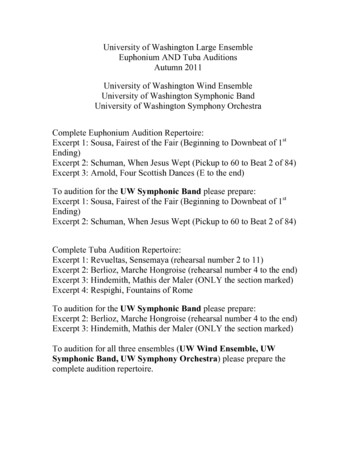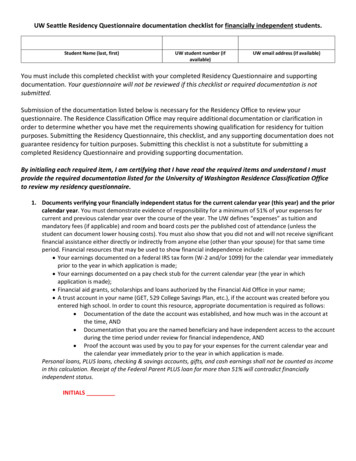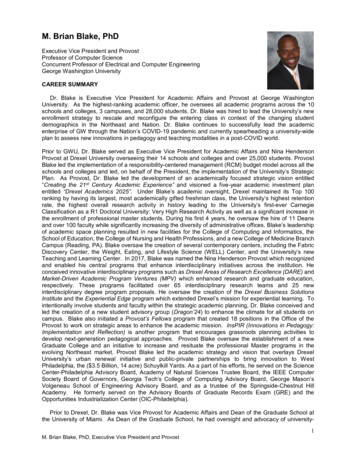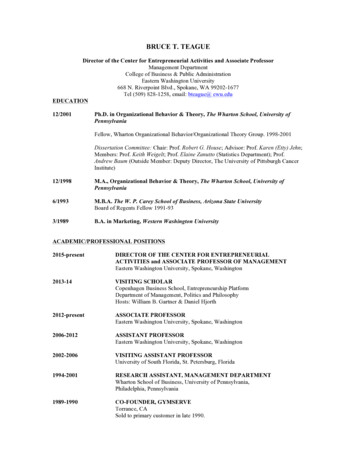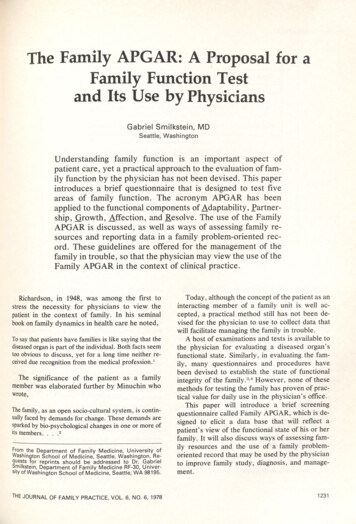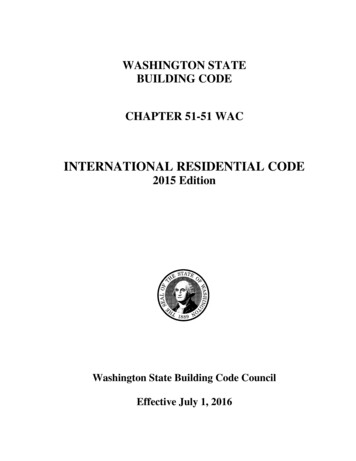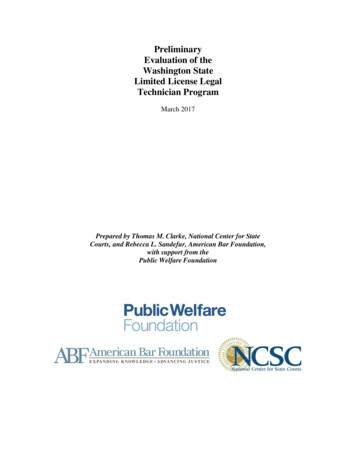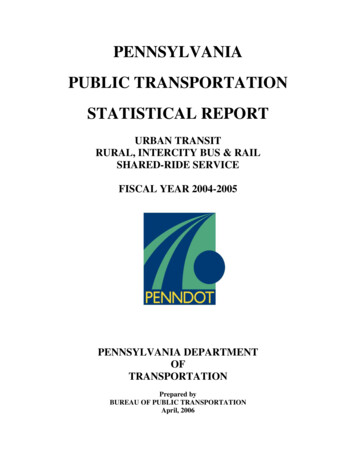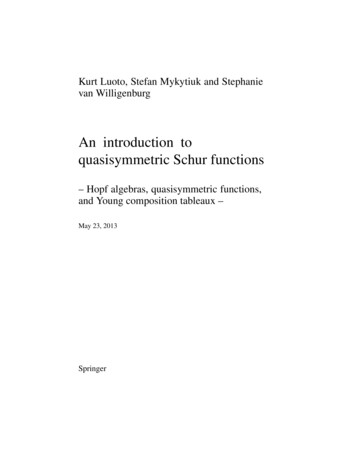
Transcription
Kurt Luoto, Stefan Mykytiuk and Stephanievan WilligenburgAn introduction toquasisymmetric Schur functions– Hopf algebras, quasisymmetric functions,and Young composition tableaux –May 23, 2013Springer
For Niall Christie and Madge Luoto
PrefaceThe history of quasisymmetric functions begins in 1972 with the thesis of RichardStanley, followed by the formal definition of the Hopf algebra of quasisymmetricfunctions in 1984 by Ira Gessel. From this definition a whole research area grew anda more detailed, although not exhaustive, history can be found in the introduction.The history of quasisymmetric Schur functions is far more contemporary. Theywere discovered in 2007 during the semester on “Recent Advances in Combinatorics” at the Centre de Recherches Mathématiques, and further progress was madeat a variety of workshops at the Banff International Research Station and during anAlexander von Humboldt Foundation Fellowship awarded to Steph. The idea forwriting this book came from encouragement by Adriano Garsia who suggested werecast quasisymmetric Schur functions using tableaux analogous to Young tableaux.We followed his words of wisdom.The aim of this monograph is twofold. The first goal is to provide a reference textfor the basic theory of Hopf algebras, in particular the Hopf algebras of symmetric,quasisymmetric and noncommutative symmetric functions and connections betweenthem. The second goal is to give a survey of results with respect to an excitingnew basis of the Hopf algebra of quasisymmetric functions, whose combinatorics isanalogous to that of the renowned Schur functions.In particular, after introducing the topic in Chapter 1, in Chapter 2 we reviewpertinent combinatorial concepts such as partially ordered sets, Young and reversetableaux, and Schensted insertion. In Chapter 3 we give the basic theory of Hopfalgebras, illustrating it with the Hopf algebras of symmetric, quasisymmetric andnoncommutative symmetric functions, ending with a brief introduction to combinatorial Hopf algebras. The exposition is based on Stefan’s thesis, useful personalnotes made by Kurt, and a talk Steph gave entitled “Everything you wanted to knowabout Sym, QSym and NSym but were afraid to ask”. Chapter 4 generalizes concepts from Chapter 2 such as Young tableaux and reverse tableaux indexed by partitions, to Young composition tableaux and reverse composition tableaux indexedby compositions. The final chapter then introduces two natural refinements for theSchur functions from Chapter 3: quasisymmetric Schur functions reliant on reversecomposition tableaux, and Young quasisymmetric Schur functions reliant on Youngvii
viiiPrefacecomposition tableaux. This chapter concludes by discussing a number of results forthese Schur function refinements and their dual bases. These results are analogousto those found in the theory of Schur functions such as the computation of Kostkanumbers, and Pieri and Littlewood-Richardson rules. Throughout parallel construction is used so that analogies may easily be spotted even when browsing.None of this would be possible without the support of a number of people, whomwe would now like to thank. Firstly, Adriano Garsia has our sincere thanks for hisardent support of pursuing quasisymmetric Schur functions. We are also grateful toour advisors and mentors who introduced us to, and fuelled our enthusiasm for, quasisymmetric functions: Nantel Bergeron, Lou Billera, Sara Billey, Isabella Novik,and Frank Sottile. This enthusiasm was sustained by our coauthors on our papersinvolving quasisymmetric Schur functions: Christine Bessenrodt, Jim Haglund, andSarah Mason, with whom it was such a pleasure to do research. We are also fortunate to have visited a variety of stimulating institutes to conduct our research andour thanks go to Francois Bergeron and a host of enthusiastic colleagues who arranged the aforementioned semester. Plus we are most grateful for the opportunitiesat Banff afforded to us by the director of BIRS, Nassif Ghoussoub, and his team,the organizers of each of the meetings we attended and the participants all of whomgave us a stimulating and supportive atmosphere for us to pursue our goals. We arealso grateful to the reviewers of this book, to Ole Warnaar, and to Moss Sweedlerfor their advice.Our various universities, York University, the University of Washington and theUniversity of British Columbia are thanked for their support, in particular the A ECombinatorics reading group at the latter: Omer Angel, Caleb Cheek, Andrew Rechnitzer, Tom Wong, and especially Ed Richmond and Vasu Tewari both of whomkindly agreed to proofread this manuscript. No research is possible without funding, and we are grateful to be supported by the Natural Sciences and EngineeringResearch Council of Canada and the Alexander von Humboldt Foundation.We would also like to thank Razia Amzad at Springer US for her help and supportduring the preparation of this manuscript, and our families and friends for all theirlove and support. Lastly, we would like to thank you, the reader, who we hope findsour book a rewarding read.Toronto and VancouverCanadaMay 2013Kurt LuotoStefan MykytiukStephanie van Willigenburg
Contents1Introduction . . . . . . . . . . . . . . . . . . . . . . . . . . . . . . . . . . . . . . . . . . . . . . . . . . .1.1 A brief history of quasisymmetric functions . . . . . . . . . . . . . . . . . . . .2Classical combinatorial concepts . . . . . . . . . . . . . . . . . . . . . . . . . . . . . . . . . 52.1 Partially ordered sets . . . . . . . . . . . . . . . . . . . . . . . . . . . . . . . . . . . . . . . . 52.2 Compositions and partitions . . . . . . . . . . . . . . . . . . . . . . . . . . . . . . . . . . 72.3 Partition diagrams . . . . . . . . . . . . . . . . . . . . . . . . . . . . . . . . . . . . . . . . . . 92.4 Young tableaux and Young’s lattice . . . . . . . . . . . . . . . . . . . . . . . . . . . 112.5 Reverse tableaux . . . . . . . . . . . . . . . . . . . . . . . . . . . . . . . . . . . . . . . . . . . 142.6 Schensted insertion . . . . . . . . . . . . . . . . . . . . . . . . . . . . . . . . . . . . . . . . . 163Hopf algebras . . . . . . . . . . . . . . . . . . . . . . . . . . . . . . . . . . . . . . . . . . . . . . . . .3.1 Hopf algebra basic theory . . . . . . . . . . . . . . . . . . . . . . . . . . . . . . . . . . . .3.2 The Hopf algebra of symmetric functions . . . . . . . . . . . . . . . . . . . . . .3.2.1 Products and coproducts . . . . . . . . . . . . . . . . . . . . . . . . . . . . . .3.2.2 Duality . . . . . . . . . . . . . . . . . . . . . . . . . . . . . . . . . . . . . . . . . . . . .3.3 The Hopf algebra of quasisymmetric functions . . . . . . . . . . . . . . . . . .3.3.1 Products and coproducts . . . . . . . . . . . . . . . . . . . . . . . . . . . . . .3.3.2 P-partitions . . . . . . . . . . . . . . . . . . . . . . . . . . . . . . . . . . . . . . . . .3.4 The Hopf algebra of noncommutative symmetric functions . . . . . . . .3.4.1 Products and coproducts . . . . . . . . . . . . . . . . . . . . . . . . . . . . . .3.4.2 Duality . . . . . . . . . . . . . . . . . . . . . . . . . . . . . . . . . . . . . . . . . . . . .3.5 Relationship between Sym, QSym, and NSym . . . . . . . . . . . . . . . . . .3.6 Automorphisms . . . . . . . . . . . . . . . . . . . . . . . . . . . . . . . . . . . . . . . . . . . .3.7 Combinatorial Hopf algebras . . . . . . . . . . . . . . . . . . . . . . . . . . . . . . . . .19192429313133354345454646474Composition tableaux and further combinatorial concepts . . . . . . . . . .4.1 Young composition tableaux and the Young composition poset . . . .4.2 Reverse composition tableaux and the reverse composition poset . . .4.3 Bijections between composition tableaux and other tableaux . . . . . .4949535711ix
x5ContentsQuasisymmetric Schur functions . . . . . . . . . . . . . . . . . . . . . . . . . . . . . . . . .5.1 Original quasisymmetric Schur functions . . . . . . . . . . . . . . . . . . . . . . .5.2 Young quasisymmetric Schur functions . . . . . . . . . . . . . . . . . . . . . . . .5.3 Pieri and Littlewood-Richardson rules in QSym using reversecomposition tableaux . . . . . . . . . . . . . . . . . . . . . . . . . . . . . . . . . . . . . . .5.4 Pieri and Littlewood-Richardson rules in QSym using Youngcomposition tableaux . . . . . . . . . . . . . . . . . . . . . . . . . . . . . . . . . . . . . . .5.5 Pieri and Littlewood-Richardson rules in NSym using reversecomposition tableaux . . . . . . . . . . . . . . . . . . . . . . . . . . . . . . . . . . . . . . .5.6 Pieri and Littlewood-Richardson rules in NSym using Youngcomposition tableaux . . . . . . . . . . . . . . . . . . . . . . . . . . . . . . . . . . . . . . .61616366707476References . . . . . . . . . . . . . . . . . . . . . . . . . . . . . . . . . . . . . . . . . . . . . . . . . . . . . . . . . 81Index . . . . . . . . . . . . . . . . . . . . . . . . . . . . . . . . . . . . . . . . . . . . . . . . . . . . . . . . . . . . . 85
Notationαeααcαrαtα č βα ĉ βcompositionunderlying partition of αcomplement of αreversal of αtranspose of αskew shapeskew shapecolcompcontχcolumn sequence of a tableaucomposition corresponding to a subset, or to a descent set of a tableaucontent of a tableauforgetful mapdDDesδi j descent set of a permutationdescent set of a chaindescent set of a tableau1 if i j and 0 otherwisecoalgebra coproducteλeαelementary symmetric functionelementary noncommutative symmetric functionFαfundamental quasisymmetric functionHH hλhαHopf algebradual Hopf algebracomplete homogeneous symmetric functioncomplete homogeneous noncommutative symmetric function Llength of a composition or partitionset of linear extensions of a posetxi
xiiNotationLčLĉLYλλtλ /µreverse composition posetYoung composition posetYoung’s latticepartitiontranspose of λskew shapemλMαmonomial symmetric functionmonomial quasisymmetric function[n]NSymthe set {1, 2, . . . , n}Hopf algebra of noncommutative symmetric functionsPP Pposetdual posetP-tableau of a listQSymHopf algebra of quasisymmetric functionsrαrαρ̌αρ̂αribbon Schur functionnoncommutative ribbon Schur functionbijection between SSRCT and SSRTbijection between SSYCT and podeset corresponding to a compositionshape of a tableauSchur functionquasisymmetric Schur functionYoung quasisymmetric Schur functionnoncommutative Schur functionYoung noncommutative Schur functionstandard reverse tableaustandard reverse composition tableausemistandard reverse tableausemistandard reverse composition tableauHopf algebra of symmetric functionsstandard Young tableaustandard Young composition tableausemistandard Young tableausemistandard Young composition tableausymmetric groupŤTreverse tableauYoung tableauSSRCTSymSY TSYCTSSY TSSYCT
Notationxiiiτ̌τreverse composition tableauYoung composition tableauǓαUαcanonical standard reverse composition tableaucanonical standard Young composition tableauV̌λVλcanonical standard reverse tableaucanonical standard Young tableauwcolcolumn reading word of a tableauxTmonomial of a tableau0/ ·empty compositionis a partition ofis a composition ofweight of a composition or partition, or size of a skew shapeconcatenation of compositionsnear concatenation of compositionsshuffle of permutationsdisjoint union of posetscover relation in a posetrelation in a posetrefinessubset of, or containmentclosed interval in a posetopen interval in a posetbilinear form, or inner product l64 [, ](, )h, i
Chapter 1IntroductionAbstract A brief history of the Hopf algebra of quasisymmetric functions is given,along with their appearance in discrete geometry, representation theory and algebra.A discussion on how quasisymmetric functions simplify other algebraic functions isundertaken, and their appearance in areas such as probability, topology, and graphtheory is also covered. Research on the dual algebra of noncommutative symmetricfunctions is touched on, as is a variety of extensions to quasisymmetric functions.What is known about the basis of quasisymmetric Schur functions is also addressed.1.1 A brief history of quasisymmetric functionsWe begin with a brief history of quasisymmetric functions ending with the recentdiscovery of quasisymmetric Schur functions, which will give an indication of thedepth and breadth of this fascinating subject.The history starts with plane partitions that were discovered by MacMahon [61]and later connected to the theory of symmetric functions by, for example, Benderand Knuth [9]. MacMahon’s work anticipated the theory of P-partitions, which wasfirst developed explicitly by Stanley [77] in 1972, and laid out the basic theory ofquasisymmetric functions in this context, but not in the language of quasisymmetricfunctions. The definition of quasisymmetric functions was given in 1984 by Gessel[35] who also described many of the fundamental properties of the Hopf algebraof quasisymmetric functions, QSym. Ehrenborg [27] developed further Hopf algebraic properties of quasisymmetric functions, and employed them to encode the flagf -vector of a poset, meanwhile proving that QSym is dual to Solomon’s descent algebra of type A was done by Malvenuto and Reutenauer [62] in 1995. It was at thispoint in time that the study of QSym and related algebras began to fully blossom.The theory of descent algebras of Coxeter groups [76] was already a rich subject in type A, for example [32], and in [34] Solomon’s descent algebra of typeA was shown to be isomorphic to the Hopf algebra of noncommutative symmetricfunctions NSym. This latter algebra is isomorphic [41] to the universal enveloping1
21 Introductionalgebra of the free Lie algebra with countably many generators [71] and formed thebasis of another fruitful avenue of research, for example, [26, 34, 51]. This avenueled to extending noncommutative symmetric functions to more than one parameter[54], coloured trees [85] and noncommutative character theory [21].With strong connections to discrete geometry [27, 35] quasisymmetric functionsalso arise frequently in areas within discrete geometry such as in the study of posets[53, 66, 80, 83], combinatorial polytopes [22], matroids [19, 24, 59] and the cdindex [17]. Plus there is a natural strong connection to algebra, and the Hopf algebra of quasisymmetric functions is isomorphic to the Hopf algebra of ladders [30], isfree over the Hopf algebra of symmetric functions [33], and can have its polynomialgenerators computed [44]. Further algebraic properties can be found in [42, 43].QSym is also the terminal object in the category of combinatorial Hopf algebras [4],and facilitates the computation of their characters [67]. Meanwhile, in the context ofrepresentation theory, quasisymmetric functions arise in the study of Hecke algebras[46], Lie representations [36], crystal graphs for general linear Lie superalgebras[52], and explicit formulas for the odd and even parts of the universal character onQSym are given in [2]. However, it is arguable that quasisymmetric functions havehad the greatest impact in simplifying the computation of many well-known functions. Examples include Macdonald polynomials [38, 40], skew Hall-Littlewoodpolynomials [58], Kazhdan-Lusztig polynomials [16], Stanley symmetric functions[78], shifted quasisymmetric functions [13, 20] and the plethysm of Schur functions[57]. Many other examples arise through the theory of Pieri operators on posets [12].Quasisymmetric functions also arise in the study of Tchebyshev transformswhere the Tchebyshev transform of the second kind is a Hopf algebra endomorphism on QSym [28] used as a tool in establishing Schur positivity [5]. With respectto ribbon Schur functions, the sum of fundamental quasisymmetric functions over aforgotten class is a multiplicity free sum of ribbon Schur functions [70], while fundamental quasisymmetric functions are key to determining when two ribbon Schurfunctions are equal [18]. In graph theory, quasisymmetric functions can be used todescribe the chromatic symmetric function [23, 79], and recently quasisymmetricrefinements of the chromatic symmetric function have been introduced [50, 75]. Inenumerative combinatorics, quasisymmetric functions are combined with the statistics of major index and excedance to create Eulerian quasisymmetric functions [74]although these functions are, in fact, symmetric. The topology of QSym has beenstudied in [7, 37] and its impact on probability comes via the study of riffle shuffles[82] and random walks [45]. Quasisymmetric functions also play a role in the studyof trees [47, 87], and the KP hierarchy [25].Generalizations and extensions of QSym are also numerous and include theMalvenuto-Reutenauer Hopf algebra of permutations, denoted by S Sym or FQSym,for example [3, 26, 62]; quasisymmetric functions in noncommuting variables, forexample [10]; higher level quasisymmetric functions, for example [48]; colouredquasisymmetric functions, for example [49]; Type B quasisymmetric functions, forexample [8]; and the space Rn constructed as a quotient by the ideal of quasisymmetric polynomials with no constant term, for example [6].
1.1 A brief history of quasisymmetric functions3Recently, a new basis of QSym has been discovered: the basis of quasisymmetricSchur functions [40], which arises from the combinatorics of Macdonald polynomials [38]. Schur functions are a basis for the Hopf algebra of symmetric functions,Sym, and are a central object of study due to their omnipresent nature: from beinggenerating functions for tableaux to being irreducible characters of the general lineargroups. Their ubiquity is well documented in classic texts such as [31, 60, 72, 81].Quasisymmetric Schur functions refine Schur functions in a natural way and, moreover, exhibit many of the elegant properties of Schur functions. Properties includeexhibiting quasisymmetric Kostka numbers [40] and Littlewood-Richardson rules[15, 39], while their image under the involution ω yields row-strict quasisymmetric Schur functions [29, 65]. Additionally quasisymmetric Schur functions have hadcertain multiplicity free expansions computed [14], and were pivotal in resolving aconjecture of F. Bergeron and Reutenauer that QSym over Sym has a stable basis[55]. They can also be used to prove Schur positivity in two stages: if a functionis proved to be both quasisymmetric Schur positive and symmetric, then it is Schurpositive.While much has been done, there is still, without doubt, a plethora of theoremsto discover about quasisymmetric Schur functions.
Chapter 2Classical combinatorial conceptsAbstract In this chapter we begin by defining partially ordered sets, linear extensions, the dual of a poset, and the disjoint union of two posets. We then define furthercombinatorial objects we will need including compositions, partitions, diagrams andYoung tableaux, reverse tableaux, Young’s lattice and Schensted insertion.2.1 Partially ordered setsA useful notion for us throughout this book will be that of a partially ordered set.Definition 2.1.1. A partially ordered set, or simply poset, is a pair (P, 6) consistingof a set P and a binary relation 6 on P that is reflexive, antisymmetric and transitive,that is, for all p, q, r P,1. p 6 p2. p 6 q and q 6 p implies p q3. p 6 q and q 6 r implies p 6 r.The relation 6 is called a partial order on or partial ordering of P.We write p q if p 6 q and p 6 q, p q if q 6 p, and p q if q p. Elementsp, q P are called comparable if p 6 q or q 6 p.If p 6 q, then we define the closed interval[p, q] {r P p 6 r 6 q}and the open interval(p, q) {r P p r q}.An element q covers an element p if p q and (p, q) 0./ If q covers p, then wewrite p l q.A chain is a poset in which any two elements are comparable. The order here iscalled a total or linear order. A saturated chain of length n 1 in a poset is a subset5
62 Classical combinatorial conceptswith order q1 l · · · l qn . For our purposes we say a poset is graded if it has a uniqueminimal element 0̂ and every saturated chain between 0̂ and a poset element x hasthe same length, called the rank of x.Example 2.1.2. Familiar posets include (Z, 6) where 6 is the usual relation lessthan or equal to on the integers, and (P(A), ) where P(A) is the collection of allsubsets of a set A. In addition, the poset (Z, 6) is a chain.We shall often abuse notation and give both a poset and its underlying set thesame name. Thus a poset P shall mean, unless otherwise specified, a set P togetherwith a partial order on P. The partial order will usually be denoted by the symbol6, with the words ‘in P’, or subscript P, added if necessary to distinguish it fromthe partial order on a different poset.We will be interested in chains that contain a given poset in the following sense.Definition 2.1.3. A linear extension of a poset P is a chain w consisting of the set Pwith a total order that satisfiesp q in P implies p q in w.When P is finite, we can let this total order be w1 w2 · · · and restate the lastcondition aswi w j in P implies i j.The set of all linear extensions of P is denoted by L (P).Example 2.1.4. There are two linear extensions of (P({1, 2}), ), namely0/ {1} {2} {1, 2}and0/ {2} {1} {1, 2}.Finally, we introduce two operations on posets. The dual of a poset P is the posetP consisting of the set P with partial order defined byp 6 q in P if q 6 p in P.If P and Q are posets with disjoint underlying sets P and Q, then the disjointunion P Q is the poset consisting of the set P Q with partial order defined byp 6 q in P Q if p 6 q in P or p 6 q in Q.Since P and Q are disjoint, p 6 q in P Q is possible only if p, q P or p, q Q.
2.2 Compositions and partitions72.2 Compositions and partitionsCompositions and partitions will be the foundation for the indexing sets of the functions we will be studying.Definition 2.2.1. A composition is a finite ordered list of positive integers. A partition is a finite unordered list of positive integers that we write in weakly decreasingorder when read from left to right. In both cases we call the integers the parts of thecomposition or partition.e , is the partition obThe underlying partition of a composition α, denoted by αtained by sorting the parts of α into weakly decreasing order.Given a composition or partition α (α1 , . . . , αk ), we define its weight or size tobe α α1 · · · αk and its length to be (α) k. When α j 1 · · · α j m iwe often abbreviate this sublist to im . If α is a composition with α n, then wewrite α n and say α is a composition of n. If λ is a partition with λ n, then wewrite λ n and say λ is a partition of n. For convenience we denote by 0/ the uniquecomposition or partition of weight and length 0, called the empty composition orpartition.Example 2.2.2. The compositions of 4 are(4), (3, 1), (1, 3), (2, 2), (2, 1, 1), (1, 2, 1), (1, 1, 2), (1, 1, 1, 1).The partitions of 4 are(4), (3, 1), (2, 2), (2, 1, 1), (1, 1, 1, 1).e (4, 2, 1, 1).If α (1, 4, 1, 2), then αLet [n] {1, 2, . . . , n}. There is a natural one-to-one correspondence betweencompositions of n and subsets of [n 1], given by the following.Definition 2.2.3. Let n be a nonnegative integer.1. If α (α1 , . . . , αk ) n, then we defineset(α) {α1 , α1 α2 , . . . , α1 · · · αk 1 } [n 1].2. If A {a1 , . . . , a } [n 1] where a1 · · · a , then we definecomp(A) (a1 , a2 a1 , . . . , a a 1 , n a ) n.In particular, the empty set corresponds to the composition 0/ if n 0, and to (n) ifn 0.Example 2.2.4. Let α (1, 1, 3, 1, 2) 8. Thenset(α) {1, 1 1, 1 1 3, 1 1 3 1} {1, 2, 5, 6} [7].
82 Classical combinatorial conceptsConversely, if A {1, 2, 5, 6} [7], thencomp(A) (1, 2 1, 5 2, 6 5, 8 6) (1, 1, 3, 1, 2).For every composition α n there exist three closely related compositions: itsreversal, its complement, and its transpose. Firstly, the reversal of α, denoted by α r ,is obtained by writing the parts of α in the reverse order. Secondly, the complementof α, denoted by α c , is given byα c comp(set(α)c ),that is, α c is the composition that corresponds to the complement of the set thatcorresponds to α. Lastly, the transpose (also known as the conjugate) of α, denotedby α t , is defined to be α t (α r )c (α c )r .Example 2.2.5. If α (1, 4, 1, 2) 8, then set(α) {1, 5, 6} [7], and hence α r (2, 1, 4, 1), α c (2, 1, 1, 3, 1), α t (1, 3, 1, 1, 2).Pictorially, we can view a composition α (α1 , . . . , αk ) as a row consisting ofα1 dots, then a bar followed by α2 dots, then a bar followed by α3 dots, and so on.We can use the picture of α to create the pictures of α r , α c , α t as follows.To create the picture of α r , reflect the picture of α in a vertical axis. To createthe picture of α c , place a bar between two dots if there is no bar between the corresponding dots in the picture of α. Finally, create the picture of α t by performingone of these actions, then using the resulting picture to perform the other action.Example 2.2.6. Repeating our previous example, if α (1, 4, 1, 2) then the pictureof α is so to compute α r , α c , α t we draw the pictures , , to obtain α r (2, 1, 4, 1), α c (2, 1, 1, 3, 1), α t (1, 3, 1, 1, 2).Given a pair of compositions, there are also two operations that can be performed.The concatenation of α (α1 , . . . , αk ) and β (β1 , . . . , β ) isα · β (α1 , . . . , αk , β1 , . . . , β )while the near concatenation isαβ (α1 , . . . , αk β1 , . . . , β ).For example, (1, 4, 1, 2) · (3, 1, 1) (1, 4, 1, 2, 3, 1, 1) while (1, 4, 1, 2) (3, 1, 1) (1, 4, 1, 5, 1, 1).Given compositions α, β , we say that α is a coarsening of β (or equivalently βis a refinement of α), denoted by α β , if we can obtain the parts of α in order byadding together adjacent parts of β in order. For example, (1, 4, 1, 2) (1, 1, 3, 1, 2).
2.3 Partition diagrams9We end this section with the following result on refinement, which is straightforward to verify, and is illustrated by Examples 2.2.4 and 2.2.5 and the definition ofrefinement.Proposition 2.2.7. Let α and β be compositions of the same weight. Thenα 4 β if and only if set(β ) set(α).2.3 Partition diagramsWe now associate compositions and partitions with diagrams.Definition 2.3.1. Given a partition λ (λ1 , . . . , λ (λ ) ) n, we say the Young diagram of λ , also denoted by λ , is the left-justified array of n cells with λi cells inthe i-th row. We follow the Cartesian or French convention, which means that wenumber the rows from bottom to top, and the columns from left to right. The cell inthe i-th row and j-th column is denoted by the pair (i, j).Example 2.3.2. The cell filled with a is the cell (2, 3). λ (4, 4, 2, 1, 1)Let λ , µ be two Young diagrams. We say µ is contained in λ , denoted by µ λ ,if (µ) 6 (λ ) and µi 6 λi for 1 6 i 6 µ (µ) . If µ λ , then we define the skew shapeλ /µ to be the array of cellsλ /µ {(i, j) (i, j) λ and (i, j) 6 µ}.For convenience, we refer to µ as the inner shape and to λ as the outer shape. Thesize of λ /µ is λ /µ λ µ . Note that the skew shape λ /0/ is the same as theYoung diagram λ . Consequently, we write λ instead of λ /0./ Such a skew shape issaid to be of straight shape.
102 Classical combinatorial conceptsExample 2.3.3. In this example the inner shape is denoted by cells filled with a ,although often these cells are not drawn. λ /µ (4, 4, 3, 2, 1)/(3, 2, 1)The transpose of a Young diagram λ , denoted by λ t , is the array of cellsλ t {( j, i) (i, j) λ }.Note that this defines the transpose of a partition.Example 2.3.4.λ (4, 4, 2, 1, 1)λ t (5, 3, 2, 2)We extend the definition of transpose to skew shapes by(λ /µ)t {( j, i) (i, j) λ and (i, j) 6 µ} λ t /µ t .Three skew shapes of particular note are horizontal strips, vertical strips andribbons. We say a skew shape is a horizontal strip if no two cells lie in the samecolumn, and a vertical strip if no two cells lie in the same row. A skew shape isconnected if for every cell d with another cell strictly below or to the right of it,there exists a cell edge-adjacent to d either below or to the right. We say a connectedskew shape is a ribbon if the following subarray of four cells does not occur in it.It follows that a ribbon is an array of cells in which, if we number rows from top tobottom, the leftmost cell of row i 1 lies immediately below the rightmost cellof row i. Consequently, a ribbon can be efficiently indexed by the compositionα (α1 , α2 , . . . , α (α) ), where αi is the number of cells in row i. This indexing,
2.4 Young tableaux and Young’s lattice11which follows [34] and involves a deviation from the Cartesian convention for numbering rows, will simplify our discussion of duality later. It also ensures that thedefinitions of transpose of a ribbon and transpose of a composition agree, as illustrated in Examples 2.2.5 and 2.3.5.Example 2.3.5.α (1, 4, 1, 2)α t (1, 3, 1, 1, 2)2.4 Young tableaux and Young’s latticeWe now take the diagrams of the previous section and fill their cells with positiveintegers to form tableaux.Definition 2.4.1. Given a skew shape λ /µ, we define a semistandard Young tableau(abbreviated to SSYT) T of shape sh(T ) λ /µ to be a fillingT : λ /µ Z of the cells of λ /µ such that1. the entries in each row are weakly increasing when read from left to right2. the entries in each column are strictly increasing when read from bottom to top.A standard Young tableau (abbreviated to SYT) is an SSYT in which the filling is abijection T : λ /µ [ λ /µ ], that is, each of the numbers 1, 2, . . . , λ /µ appearsexactly once. Sometimes we will abuse notation and use SSYTs and SYTs to denotethe set of all such tableaux.Example 2.4.2. An SSYT and SYT, respectively, ar
writing this book came from encouragement by Adriano Garsia who suggested we recast quasisymmetric Schur functions using tableaux analogous to Young tableaux. . colcolumn sequence of a tableau compcomposition corresponding to a subset, or to a descent set of a tableau

